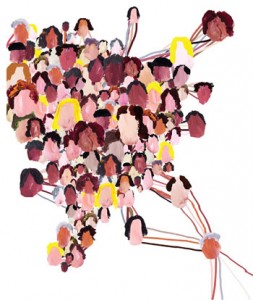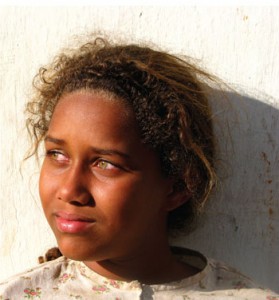 GABRIEL BITARA land inhabited by Indians, colonized by the Portuguese and where slaves were brought from several African countries. The outcome of this is what children learn in school: mestizos, half-breeds and mulattoes. “At the time of the Empire, this was not regarded kindly by the proponents of scientific racism; the emperor Dom Pedro II instituted a ‘whitening’ policy,” the geneticist Sergio Pena, from the Federal University of Minas Gerais (UFMG) reminds us. “This program, which brought into Brazil six million European immigrants, continued into the Republic and up to the 1970’s.” On the surface, it did not work: it gave rise to a continuous gradation of skin tones ranging from people with fair skin, blue eyes and blond hair to those with very dark skin and African features. However, the geneticist is now showing, in an article published in February in PLoS One, that something worked. The inhabitants of four of the country’s regions (the Midwest was not studied) have at least 60% of European ancestry in their genetic material. “We have mulatto Europeans, black Europeans and white Europeans,” Pena jokes.
GABRIEL BITARA land inhabited by Indians, colonized by the Portuguese and where slaves were brought from several African countries. The outcome of this is what children learn in school: mestizos, half-breeds and mulattoes. “At the time of the Empire, this was not regarded kindly by the proponents of scientific racism; the emperor Dom Pedro II instituted a ‘whitening’ policy,” the geneticist Sergio Pena, from the Federal University of Minas Gerais (UFMG) reminds us. “This program, which brought into Brazil six million European immigrants, continued into the Republic and up to the 1970’s.” On the surface, it did not work: it gave rise to a continuous gradation of skin tones ranging from people with fair skin, blue eyes and blond hair to those with very dark skin and African features. However, the geneticist is now showing, in an article published in February in PLoS One, that something worked. The inhabitants of four of the country’s regions (the Midwest was not studied) have at least 60% of European ancestry in their genetic material. “We have mulatto Europeans, black Europeans and white Europeans,” Pena jokes.
The team responsible for the study, which besides UFMG included researchers from the states of Bahia, Rio de Janeiro, Rio Grande do Sul, Ceará, Pará and São Paulo, analyzed samples of inhabitants of the North, Northeast, Southeast and South regions. “The sampling was well done and systematic,” explains the geneticist. The group analyzed the proportion of European, African and Amerindian ancestry in 934 people that defined themselves as white, mulatto or black, in the cities of Belém, Fortaleza, Ilhéus, Rio de Janeiro, Joinville and Porto Alegre.
The study used 40 DNA segments that other studies conducted by Pena have shown are sufficient for this type of characterization. They are parts of the genetic material that are unrelated to the features used to characterize race, such as skin and hair color. However, they are different depending on the geographic origin. The results showed that there is no necessarily direct correspondence between skin color and ancestry. This was no surprise for the geneticist from the state of Minas Gerais, who has been describing the mosaic that makes up Brazilians for quite a while (see Pesquisa FAPESP issue 134). Among some Rio de Janeiro whites, for example, the DNA segments used as markers indicated stronger African ancestry than European ancestry; in the same city, some of those who declared themselves to be black, according to the terminology of the Brazilian Geography and Statistics Institute (IBGE), turned out to be almost entirely European in terms of these markers. “There is tremendous variability between one individual and the next and these genome segments reveal the individuality of each Brazilian,” commented the researcher.
The ancestral diagrams also reveal something of the makeup of the population of the country’s regions. In Pará and Rio Grande do Sul, the presence of indigenous peoples in the genetic composition of some of the whites and mulattoes who took part in the study was observed. In Bahia and Rio de Janeiro, on the other hand, this presence was almost non-existent, whereas African ancestry was more common.
However, despite these differences, the study found a surprising homogeneity across the regions. This required using a statistical tool (something akin to a weighted average), which the researchers call “total ancestry,” to set aside the regional particularities in the respondents perceptions of their own color. “A person that describes himself as a mulatto in the North is not genetically similar to the Southern mulatto,” explains Pena, “which can be explained by a different level of exposure to the sun and also by different social contexts.” Once this variation is eliminated, the study revealed that the people of the four regions have, on average, at least 60% of European ancestry – the lowest area was the Northeast, with 61%, and the highest one was the South, with 78%. The African and Amerindian heritages, on the other hand, are less significant and more variable from one region to the next.
 PAULO MUSSOIIt is a striking result, but not yet consensual among geneticists interested in human populations. The American geneticist Alan Templeton, from Washington University in Saint Louis, is concerned with the use of self-declared race, the standard employed by IBGE. “I took part in a study with sociologists and was surprised to see that the same people do not classify themselves in the same way over time,” he explains. As the total ancestral calculation uses the IBGE survey, it would be impossible to eliminate the discrepancies of self-evaluation. One more precise alternative, according to Templeton, would be to use a method known as AIMs (ancestry-informative markers), which infer ancestry contributions with no reference to color. The problem is that this purely genetic approach would demand much more than 40 genetic markers – the American group used almost 2 thousand. Even so, in general, he agrees with Pena: “The main conclusion I would draw from these data is that the self-declared racial categories are unreliable indicators of genomic ancestry in Brazil.”
PAULO MUSSOIIt is a striking result, but not yet consensual among geneticists interested in human populations. The American geneticist Alan Templeton, from Washington University in Saint Louis, is concerned with the use of self-declared race, the standard employed by IBGE. “I took part in a study with sociologists and was surprised to see that the same people do not classify themselves in the same way over time,” he explains. As the total ancestral calculation uses the IBGE survey, it would be impossible to eliminate the discrepancies of self-evaluation. One more precise alternative, according to Templeton, would be to use a method known as AIMs (ancestry-informative markers), which infer ancestry contributions with no reference to color. The problem is that this purely genetic approach would demand much more than 40 genetic markers – the American group used almost 2 thousand. Even so, in general, he agrees with Pena: “The main conclusion I would draw from these data is that the self-declared racial categories are unreliable indicators of genomic ancestry in Brazil.”
In practice
The study led by Pena has important medical significance. It was no accident that he took part in the Brazilian Network of Pharmacogenetics study on how the genetic composition of each person influences the metabolism of pharmaceutical drugs, with a view to developing personalized medical treatment. The work of characterizing the ancestry of Brazilians is being used as a basis for other studies and, according to the geneticist, should change the accepted validity of pharmacological studies. “It’s common to state that the studies conducted in the South aren’t valid for the North, because the ethnic makeup is different; we have shown that this is not the case.” In other countries, a variation in the susceptibility to diseases and in the response to drugs depending on ethnicity has been observed.
Pena argues that the important thing to understand in the Brazilian case, what counts, is ancestry rather than skin color. Henceforth, according to this view, pharmacological studies should include information about the participants’ ancestry. Furthermore, in those cases in which a drug works better for certain ethnic groups than for others, it would be necessary to draw up the patient’s ancestral profile before determining the treatment.
For Pena, from the social standpoint, the results strengthen what he has been advocating for years: “There is no justification for wanting to ‘racialize’ Brazil.” This notion might have some impact on the quotas policy, given that a dark-skinned person might have more European ancestors than one with fairer skin. However, he admits that things are not that simple. After all, discrimination is based on what is visible, not on DNA analyses. “There are no races, but racists don’t care about this fact,” he states, ironically.
Besides teaching at UFMG, Sergio Pena also provides several types of genetic testing – including ancestry profiles – at his company, Gene, a pioneer in this field in Latin America. According to him, understanding the mosaic that forms Brazilians and that makes each person impossible to define as to his or her ethnic makeup has a far deeper importance than its practical applications. “We are seeing ourselves as people,” he states proudly. “More than ever before, Brazil, despite its continental dimensions, is a single country.”
Scientific article
PENA, S. D. J. et al. The genomic ancestry of individuals from different geographical regions of Brazil is more uniform than expected. PLoS One. v. 6, n. 2. 2011.
